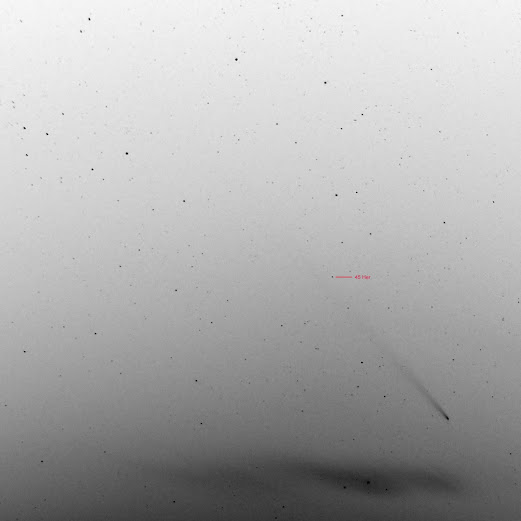There has been a lot of hype about this comet in the press and, whilst it is good to bring this object to the attention of the public, over doing can mean that ordinary folks get disappointed. This was definitely not a great comet like Hale-Bopp and, although the window when you could just about see it with the naked eye was short, it has put on a reasonable display.
This long-period comet was discovered in February 2023 by ATLAS - the Asteroid Terrestrial-impact Last Alert System. After its orbit had been calculated it was noted that it had also been seen at the Purple Mountain Observatory in China, hence the dual name Tsuchinshan-Atlas. Much has been made of its 80,660 year orbital period around the sun ("your last chance to see this comet for over 80,000 years") but, in reality, four fifths of all comets are long-period, so most are "once in a lifetime".
When this comet swung into the inner solar system and became more visible to us it was a difficult morning object and seen just before sunrise. After solar conjunction the comet became an evening object in the period after October 10th. I had my first good view of it on October 18th:-
This was a single 10s exposure taken on a Nikon D90 with a Nikkor VR 18-105 f/3.5-5.6 ED lens at 18mm (ISO 800 at f/3.5). It was taken at 18:24 UT (19:24 BST) and about an hour and 20 minutes after sunset. The full moon (one day past full) was rising in the east behind me. The comet at this time was in the constellation of Serpens (Caput) and close to the border with Ophiuchus (one of the nearer stars was sigma Serpentis). This view looks sort of south west. You can see that it has a long tail streaming out behind it.
I took a number of such 10s frames and combined them together in Photoshop. Here is a cropped version of the result (16x10s, same settings as before):-
This shows the tail more clearly stretching up towards the top of the picture. I was curious to work out exactly how long the tail was and so I took this picture and made it monochrome, inverted it and increased the contrast.
In this version of the image I have marked the star 45 Herculis whose coordinates are RA 16h 47m 46s, Dec. +05 deg 14' 48''. Knowing that the comet was at position of RA 16h 08m 01s, Dec. +01 deg 52' 23'' at the time the photo was taken, we can determine the angular separation of the comet and this star. This works out to be 10.5 degrees. So the tail is longer than this and by rough measurement it is at least 12.2 degrees long.
Four days later (the 22nd October) the comet had already moved eastwards quite a bit into the constellation of Ophiuchus and I was able to see it with binoculars from my garden:-
This was a combination of 8x10s exposures at ISO3200 taken at the slightly later time of 18:44UT (same camera as before but at 48mm focal length). The image has been cropped. The bright star near the centre of the frame and just below the tail of the comet is sigma Ophiuchi. This field is 12x12 degrees and so the tail is perhaps as not as extensive as it was a few days before.
All text and images © Duncan Hale-Sutton 2024





No comments:
Post a Comment